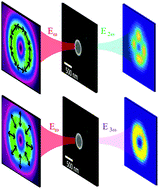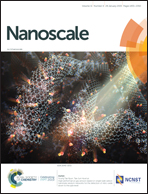Resonant harmonic generation in AlGaAs nanoantennas probed by cylindrical vector beams†
Abstract
We investigate second- and third-harmonic generation from individual AlGaAs nanoantennas using far-field mapping with radially- and azimuthally-polarized cylindrical vector beams. Due to the unique polarization structure of these beams, we are able to determine the crystal orientation of the nanoantenna in a single scanning map. Our method thus provides a novel and versatile optical tool to study the crystal properties of semiconductor nanoantennas. We also demonstrate the influence of cylindrical vector beam excitation on the resonant enhancement of second- and third-harmonic generation driven by electric and magnetic anapole-like modes, despite falling in the strong absorption regime of AlGaAs. In particular, we observe a greater nonlinear conversion efficiency from a single nanoantenna excited with a radially-polarized beam as compared to an azimuthally polarized cylindrical vector beam. The fundamental field of the radially-polarized beam strongly couples to the multipoles increasing the near-field enhancement of the nanoantenna. Our work introduces new ways to study individual nanostructures and to tailor the efficiencies of nonlinear phenomena at the nanoscale using non-conventional optical techniques.



 Please wait while we load your content...
Please wait while we load your content...